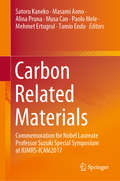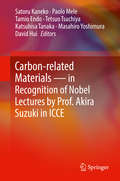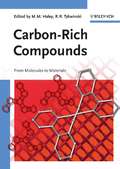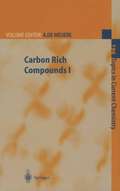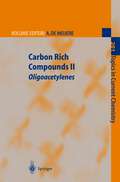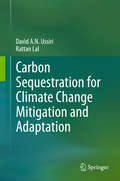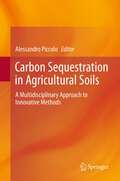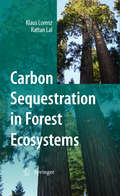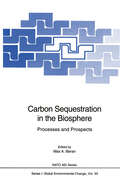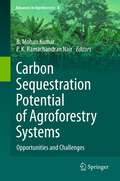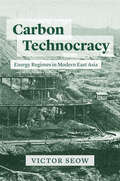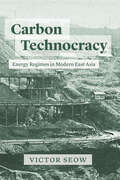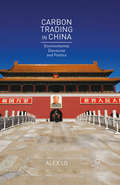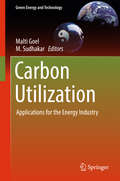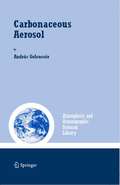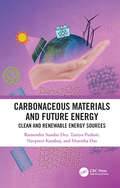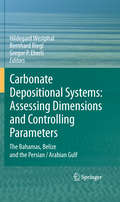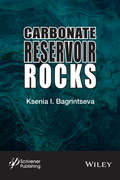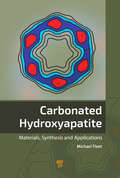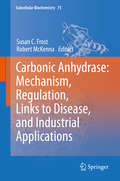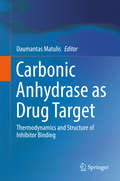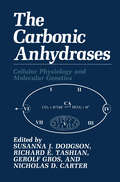- Table View
- List View
Carbon Related Materials: Commemoration for Nobel Laureate Professor Suzuki Special Symposium at IUMRS-ICAM2017
by Satoru Kaneko Masami Aono Alina Pruna Musa Can Paolo Mele Mehmet Ertugrul Tamio EndoThis book commemorates the “Nobel Laureate Professor Suzuki Special Symposium” at the International Union of Material Research Society–International Conference on Advanced Materials (IUMRS-ICAM2017), which was held at Kyoto University, Japan, in 2017. The book begins with a foreword by Professor Akira Suzuki. Subsequently, many authors who attended the special symposium describe the latest scientific advances in the field of carbon materials and carbon nanomaterials including polymers, carbon nanocomposites, and graphene. Carbon-based materials have recently been the focus of considerable attention, given their wide range of potential applications. Fittingly, the chapters in this book cover both experimental and theoretical approaches in several categories of carbon-related materials.
Carbon-related Materials in Recognition of Nobel Lectures by Prof. Akira Suzuki in ICCE
by Satoru Kaneko Paolo Mele Tamio Endo Tetsuo Tsuchiya Katsuhisa Tanaka Masahiro Yoshimura David HuiThis book summarizes the recent advances in carbon-related materials. It covers both experimental and theoretical approaches in graphene and nanocarbon materials, carbon composites and thin films, organic synthesis and physical chemistry, and characterization tools. Also discussed are cutting-edge applications for use in biochemical assays, dental implant surface modifi cations, pressure sensors, and more. This book is published in recognition of the Nobel Lectures delivered by Akira Suzuki, Emeritus Professor of Hokkaido University and Nobel Prize winner in Chemistry, 2010.
Carbon-Rich Compounds: From Molecules to Materials
by Michael M. Haley Rik R. TykwinskiThis is the only up-to-date book on the market to focus on the synthesis of these compounds in this particularly suitable way. A team of excellent international authors guarantees high-quality content, covering such topics as monodisperse carbon-rich oligomers, molecular electronic wires, polyaromatic hydrocarbons, nonconjugated small molecules, nanotubes, fullerenes, polyynes, macrocycles, dendrimers, phenylenes and diamondoid structures. The result is a must-have for everyone working in this expanding and interdisciplinary field, including organic and polymer chemists, materials scientists, and chemists working in industry.
Carbon Rich Compounds I (Topics in Current Chemistry #196)
by A. De Meijere R. Haag S. Hagen H. Hopf B. König D. Kuck T. J. Seiders J. S. Siegel Y. Sritana-AnantCarbon Rich Compounds are defined here as carbon skeletons with a carbon to hydrogen ratio of 1:(=
Carbon Rich Compounds II: Macrocyclic Oligoacetylenes and Other Linearly Conjugated Systems (Topics in Current Chemistry #201)
by Armin De MeijereWith contributions by numerous experts
Carbon Sequestration for Climate Change Mitigation and Adaptation
by David A. Ussiri Rattan LalThis book provides an understanding of the role of human activities in accelerating change in global carbon cycling summarizes current knowledge of the contemporary carbon budget. Starting from the geological history, this volume follows a multidisciplinary approach to analyze the role of human activities in perturbing carbon cycling by quantifying changes in different reservoirs and fluxes of carbon with emphasis on the anthropogenic activities, especially after the industrial revolution. It covers the role of different mitigation options – natural ecological, engineered, and geoengineered processes as well as the emerging field of climate engineering in avoiding dangerous abrupt climate change. Although the targeted audience is the educators, students, researchers and scientific community, the simplified analysis and synthesis of current and up to date scientific literature makes the volume easier to understand and a tool policy makers can use to make an informed policy decisions.
Carbon Sequestration in Agricultural Soils: A Multidisciplinary Approach to Innovative Methods
by Alessandro PiccoloThis compilation of techniques, methodologies and scientific data arises from a four-year Italian research project, which took place at university research stations in Turin, Piacenza, Naples and Potenza. Soil Organic Matter (SOM) represents an active and essential pool of the total organic carbon on the planet. Consequently, even small changes in this SOM carbon pool may have a significant impact on the concentration of atmospheric CO2. Recent new understanding of the chemical nature of SOM indicates that innovative and sustainable technologies may be applied to sequester carbon in agricultural soils. Overall results of the project have been applied to develop an innovative model for the prediction and description, both quantitatively and qualitatively, of carbon sequestration in agricultural soils. This book provides experts in different areas of soil science with a complete picture of the effects of new soil management methods and their potentials for practical application in farm management.
Carbon Sequestration in Forest Ecosystems
by Klaus Lorenz Rattan LalCarbon Sequestration in Forest Ecosystems is a comprehensive book describing the basic processes of carbon dynamics in forest ecosystems, their contribution to carbon sequestration and implications for mitigating abrupt climate change. This book provides the information on processes, factors and causes influencing carbon sequestration in forest ecosystems. Drawing upon most up-to-date references, this book summarizes the current understanding of carbon sequestration processes in forest ecosystems while identifying knowledge gaps for future research, Thus, this book is a valuable knowledge source for students, scientists, forest managers and policy makers.
Carbon Sequestration in the Biosphere: Processes and Prospects (Nato ASI Subseries I: #33)
by Max A. BeranAnthropogenic release of carbon dioxide into the atmosphere has been recognized as the primary agent in global climate change. The volume discusses the possibilities for limiting that increase by the long-term storage of carbon in soils, vegetation, wetlands and oceans. Each of these storage media is analysed in detail to elucidate those processes responsible for the uptake and release of carbon. Several chapters address the practical prospects for deliberate interventions aimed at adjusting the balance in favour of uptake over release, i.e. sequestration, while having regard to simultaneous changes in the various environments.
Carbon Sequestration Potential of Agroforestry Systems: Opportunities and Challenges (Advances in Agroforestry #8)
by B. Mohan Mohan Kumar and P. K. Ramachandran K. Ramachandran NairTree based production systems abound especially in the tropics. Despite the pervasiveness of such multipurpose “trees-outside-forest” resources, they have not attracted adequate attention in the development paradigms of many nation states. These multispecies production systems impact the ecosystem processes favourably. Yet, our understanding of the diversity attributes and carbon dynamics under agroforestry is not adequate. This book focuses on the role of multispecies production systems involving tree and crop species as a means for carbon sequestration and thereby reduce atmospheric carbon dioxide levels. Sixteen chapters organized into three broad sections titled: Measurement and Estimation, Agrobiodiversity and Tree Management, and Policy and Socioeconomic Aspects represent a cross section of the opportunities and challenges in current research and emerging issues in harnessing carbon sequestration potential of agroforestry systems.
Carbon Technocracy: Energy Regimes in Modern East Asia (Studies of the Weatherhead East Asian Institute)
by Victor SeowA forceful reckoning with the relationship between energy and power through the history of what was once East Asia’s largest coal mine. The coal-mining town of Fushun in China’s Northeast is home to a monstrous open pit. First excavated in the early twentieth century, this pit grew like a widening maw over the ensuing decades, as various Chinese and Japanese states endeavored to unearth Fushun’s purportedly “inexhaustible” carbon resources. Today, the depleted mine that remains is a wondrous and terrifying monument to fantasies of a fossil-fueled future and the technologies mobilized in attempts to turn those developmentalist dreams into reality. In Carbon Technocracy, Victor Seow uses the remarkable story of the Fushun colliery to chart how the fossil fuel economy emerged in tandem with the rise of the modern technocratic state. Taking coal as an essential feedstock of national wealth and power, Chinese and Japanese bureaucrats, engineers, and industrialists deployed new technologies like open-pit mining and hydraulic stowage in pursuit of intensive energy extraction. But as much as these mine operators idealized the might of fossil fuel–driven machines, their extractive efforts nevertheless relied heavily on the human labor that those devices were expected to displace. Under the carbon energy regime, countless workers here and elsewhere would be subjected to invasive techniques of labor control, ever-escalating output targets, and the dangers of an increasingly exploited earth. Although Fushun is no longer the coal capital it once was, the pattern of aggressive fossil-fueled development that led to its ascent endures. As we confront a planetary crisis precipitated by our extravagant consumption of carbon, it holds urgent lessons. This is a groundbreaking exploration of how the mutual production of energy and power came to define industrial modernity and the wider world that carbon made.
Carbon Technocracy: Energy Regimes in Modern East Asia (Studies of the Weatherhead East Asian Institute)
by Victor SeowA forceful reckoning with the relationship between energy and power through the history of what was once East Asia’s largest coal mine. The coal-mining town of Fushun in China’s Northeast is home to a monstrous open pit. First excavated in the early twentieth century, this pit grew like a widening maw over the ensuing decades, as various Chinese and Japanese states endeavored to unearth Fushun’s purportedly “inexhaustible” carbon resources. Today, the depleted mine that remains is a wondrous and terrifying monument to fantasies of a fossil-fueled future and the technologies mobilized in attempts to turn those developmentalist dreams into reality. In Carbon Technocracy, Victor Seow uses the remarkable story of the Fushun colliery to chart how the fossil fuel economy emerged in tandem with the rise of the modern technocratic state. Taking coal as an essential feedstock of national wealth and power, Chinese and Japanese bureaucrats, engineers, and industrialists deployed new technologies like open-pit mining and hydraulic stowage in pursuit of intensive energy extraction. But as much as these mine operators idealized the might of fossil fuel–driven machines, their extractive efforts nevertheless relied heavily on the human labor that those devices were expected to displace. Under the carbon energy regime, countless workers here and elsewhere would be subjected to invasive techniques of labor control, ever-escalating output targets, and the dangers of an increasingly exploited earth. Although Fushun is no longer the coal capital it once was, the pattern of aggressive fossil-fueled development that led to its ascent endures. As we confront a planetary crisis precipitated by our extravagant consumption of carbon, it holds urgent lessons. This is a groundbreaking exploration of how the mutual production of energy and power came to define industrial modernity and the wider world that carbon made.
Carbon Technocracy: Energy Regimes in Modern East Asia (Studies of the Weatherhead East Asian Institute)
by Victor SeowA forceful reckoning with the relationship between energy and power through the history of what was once East Asia’s largest coal mine. The coal-mining town of Fushun in China’s Northeast is home to a monstrous open pit. First excavated in the early twentieth century, this pit grew like a widening maw over the ensuing decades, as various Chinese and Japanese states endeavored to unearth Fushun’s purportedly “inexhaustible” carbon resources. Today, the depleted mine that remains is a wondrous and terrifying monument to fantasies of a fossil-fueled future and the technologies mobilized in attempts to turn those developmentalist dreams into reality. In Carbon Technocracy, Victor Seow uses the remarkable story of the Fushun colliery to chart how the fossil fuel economy emerged in tandem with the rise of the modern technocratic state. Taking coal as an essential feedstock of national wealth and power, Chinese and Japanese bureaucrats, engineers, and industrialists deployed new technologies like open-pit mining and hydraulic stowage in pursuit of intensive energy extraction. But as much as these mine operators idealized the might of fossil fuel–driven machines, their extractive efforts nevertheless relied heavily on the human labor that those devices were expected to displace. Under the carbon energy regime, countless workers here and elsewhere would be subjected to invasive techniques of labor control, ever-escalating output targets, and the dangers of an increasingly exploited earth. Although Fushun is no longer the coal capital it once was, the pattern of aggressive fossil-fueled development that led to its ascent endures. As we confront a planetary crisis precipitated by our extravagant consumption of carbon, it holds urgent lessons. This is a groundbreaking exploration of how the mutual production of energy and power came to define industrial modernity and the wider world that carbon made.
Carbon Trading in China: Environmental Discourse and Politics
by Alex LoThis book explores the political aspects of China's climate change policy, focusing on the newly established carbon markets and carbon trading schemes. Lo makes a case for understanding the policy change in terms of discourse and in relation to narratives of national power and development.
Carbon Utilization: Applications for the Energy Industry (Green Energy and Technology)
by Malti Goel M. SudhakarThis book provides in-depth information on topics relating to anthropogenic carbon dioxide utilization processes. Presenting a collection of state-of-the-art scientific reviews and research perspectives on carbon management strategies of relevance to the energy industry, it features contributions by leading scientists and technocrats across 19 chapters as an Indian contribution In the energy industry, new processes for carbon dioxide removal and recycling are developing quickly, and it is in this context that the book provides an opportunity to review the current status of and promote efforts to achieve effective carbon capture and management. The contents presented here will prove useful to researchers, students, industry experts, scientists and policymakers alike.
Carbonaceous Aerosol (Atmospheric and Oceanographic Sciences Library #30)
by András GelencsérThe concept of carbonaceous aerosol has only recently emerged from atmospheric pollution studies; even standard nomenclature and terminology are still unsettled. This monograph is the first to offer comprehensive coverage of the nature and atmospheric role of carbonaceous aerosol particles. Atmospheric chemists, physicists, meteorologists, and modellers will find this a thought-inspiring and sometimes provocative overview of all global phenomena affected by or related to carbonaceous aerosol.
Carbonaceous Materials and Future Energy: Clean and Renewable Energy Sources
by Ramendra Sundar Dey Taniya Purkait Navpreet Kamboj Manisha DasModern lifestyle demands consistent supply of energy for our daily need and comfort. To encounter global demands for energy and to permit for diminution of fossil fuels, there is an urgent need for efficient, sustainable and clean energy sources. Carbonaceous material such as graphene, carbon nanotubes, fullerenes, mesoporous carbon, carbon nanofibres and their composites are extensively studied material. They are playing important role to alternative clean energy sources. This book reviews the roadmap of various form of carbonaceous materials used in several energy devices and provides guideline of future perspective.
Carbonaceous Materials and Future Energy: Clean and Renewable Energy Sources
by Ramendra Sundar Dey Taniya Purkait Navpreet Kamboj Manisha DasModern lifestyle demands consistent supply of energy for our daily need and comfort. To encounter global demands for energy and to permit for diminution of fossil fuels, there is an urgent need for efficient, sustainable and clean energy sources. Carbonaceous material such as graphene, carbon nanotubes, fullerenes, mesoporous carbon, carbon nanofibres and their composites are extensively studied material. They are playing important role to alternative clean energy sources. This book reviews the roadmap of various form of carbonaceous materials used in several energy devices and provides guideline of future perspective.
Carbonate Depositional Systems: The Bahamas, Belize and the Persian/Arabian Gulf
by Hildegard Westphal Bernhard Riegl Gregor P. P. EberliCarbonate sediments are of increasing relevance for archives of past environmental conditions and for economical reasons in areas of geothermal energy and hydrocarbon reservoirs. Complex interaction of physical and chemical parameters with biological parameters determines the architecture and composition of carbonate sedimentary bodies. This book closes some of the still existing gaps in our understanding of the influence and interplay of physical, chemical, and biological parameters with carbonate sedimentation. An understanding of this interaction is not only required for reliable prediction of reservoir quality but also for a robust interpretation of environmental conditions in the past and the present. It is written by geologists for geologists in order to provide an easily accessible overview of the large amount of relevant information provided by the neighbouring sciences. The approach of the book is to document the modern depositional environments of three classical areas of carbonate deposition, each characteristic for a specific sedimentological setting (isolated platform, attached shelf, ramp) in order to assess both the range of physical, biological and chemical parameters and their sedimentary response. This book presents a comprehensive compilation based on data from published work and unpublished theses, and the integration of these data in order to extract previously undiscovered relationships between the discussed parameters and carbonate deposition.
Carbonate Reservoir Rocks
by Ksenia I. BagrintsevaMost of the world’s energy still comes from fossil fuels, and there are still many strides being made in the efficiency and cost effectiveness of extracting these important and increasingly more elusive natural resources. This is only possible if the nature of the emergence, evolution, and parameter estimation of high grade reservoir rocks at great depths is known and a theory of their forecast is developed. Over 60 percent of world oil production is currently associated with carbonate reservoir rocks. The exploration, appraisal and development of these fields are significantly complicated by a number of factors. These factors include the structural complexity of the carbonate complexes, variability of the reservoir rock types and properties within a particular deposit, many unknowns in the evaluation of fracturing and its spatial variability, and the preservation of the reservoir rock qualities with depth. The main objective of most studies is discovering patterns in the reservoir rock property changes of carbonate deposits of different genesis, composition and age. A short list of the unsolved issues includes: the role of facies environment in the carbonate formation; the major geologic factors affecting the formation of high-capacity reservoir rocks and preservation of their properties; recommendations as to the use of the new techniques in studies of the structural parameters; and establishing a correlation between the major evaluation parameters. The focus of this volume is to show the scientific and engineering community a revolutionary process. The author perfected an earlier developed methodology in studies of the void space structure (Bagrintseva’s method, 1982). This methodology is based on carbonate rock saturation with luminophore and on special techniques in processing of photographs made under UV light. The luminophore technique was combined with the raster electron microscopy and its variation, the studies under the cathode luminescence regime. This combination enabled a more detailed study of the reservoir void space, the nonuniformity in the open fracture evolution, their morphology, length and variability of openness. Over recent years these techniques have found wide application. Useful for the veteran engineer or scientist and the student alike, this book is a must-have for any geologist, engineer, or student working in the field of upstream petroleum engineering.
Carbonate Reservoir Rocks
by Ksenia I. BagrintsevaMost of the world’s energy still comes from fossil fuels, and there are still many strides being made in the efficiency and cost effectiveness of extracting these important and increasingly more elusive natural resources. This is only possible if the nature of the emergence, evolution, and parameter estimation of high grade reservoir rocks at great depths is known and a theory of their forecast is developed. Over 60 percent of world oil production is currently associated with carbonate reservoir rocks. The exploration, appraisal and development of these fields are significantly complicated by a number of factors. These factors include the structural complexity of the carbonate complexes, variability of the reservoir rock types and properties within a particular deposit, many unknowns in the evaluation of fracturing and its spatial variability, and the preservation of the reservoir rock qualities with depth. The main objective of most studies is discovering patterns in the reservoir rock property changes of carbonate deposits of different genesis, composition and age. A short list of the unsolved issues includes: the role of facies environment in the carbonate formation; the major geologic factors affecting the formation of high-capacity reservoir rocks and preservation of their properties; recommendations as to the use of the new techniques in studies of the structural parameters; and establishing a correlation between the major evaluation parameters. The focus of this volume is to show the scientific and engineering community a revolutionary process. The author perfected an earlier developed methodology in studies of the void space structure (Bagrintseva’s method, 1982). This methodology is based on carbonate rock saturation with luminophore and on special techniques in processing of photographs made under UV light. The luminophore technique was combined with the raster electron microscopy and its variation, the studies under the cathode luminescence regime. This combination enabled a more detailed study of the reservoir void space, the nonuniformity in the open fracture evolution, their morphology, length and variability of openness. Over recent years these techniques have found wide application. Useful for the veteran engineer or scientist and the student alike, this book is a must-have for any geologist, engineer, or student working in the field of upstream petroleum engineering.
Carbonated Hydroxyapatite: Materials, Synthesis, and Applications
by Michael E. FleetThis book introduces recent advances in understanding the crystal structure of carbonate hydroxylapatite (also known as bone mineral), which forms the hard tissue of bones and teeth. Bone mineral is the reservoir for carbon dioxide in the body and maintains the concentration of mineral ions in body fluids at homeostasis. The detailed structure of b
Carbonic Anhydrase: Mechanism, Regulation, Links To Disease, And Industrial Applications (Subcellular Biochemistry #75)
by Susan C. Frost Robert McKennaThe study of carbonic anhydrase has spanned multiple generations of scientists. Carbonic anhydrase was first discovered in 1932 by Meldrum and Roughton. Inhibition by sulfanilamide was shown in 1940 by Mann and Keilin. Even Hans Krebs contributed to early studies with a paper in 1948 showing the relationship of 25 different sulfonamides to CA inhibition. It was he who pointed out the importance of both the charged and uncharged character of these compounds for physiological experiments. The field of study that focuses on carbonic anhydrase (CA) has exploded in recent years with the identification of new families and isoforms. The CAs are metalloenzymes which are comprised of 5 structurally different families: the alpha, beta, gamma, and delta, and epsilon classes. The alpha class is found primarily in animals with several isoforms associated with human disease. The beta CAs are expressed primarily in plants and are the most divergent. The gamma CAs are the most ancient. These are structurally related to the beta CAs, but have a mechanism more similar to the alpha CAs. The delta CAs are found in marine algae and diflagellates. The epsilon class is found in prokaryotes in which it is part of the carboxysome shell perhaps supplying RuBisCO with CO2 for carbon fixation. With the excitement surrounding the discovery of disease-related CAs, scientists have redoubled their efforts to better understand structure-function relationships, to design high affinity, isotype-specific inhibitors, and to delineate signaling systems that play regulatory roles over expression and activity. We have designed the book to cover basic information of mechanism, structure, and function of the CA families. The authors included in this book bring to light the newest data with regard to the role of CA in physiology and pathology, across phylums, and in unique environmental niches.
Carbonic Anhydrase as Drug Target: Thermodynamics and Structure of Inhibitor Binding
by Daumantas MatulisThis book offers deep insights into the thermodynamics and molecular structures of the twelve catalytically active isoforms of human carbonic anhydrase (CA) with a particular focus on inhibitor binding for drug design. X-ray crystallographic structures in combination with enzyme kinetic testing provide information on the interaction of CAs and their inhibitors, knowledge which is crucial for rational drug design. CAs are zinc carrying enzymes that catalyse the reversible interconversion of carbon dioxide and bicarbonate and are involved in numerous cellular processes. They are therefore a common target for drugs. The suppression of CA activities through inhibitory compounds has found application for example in diuretics and in glaucoma therapy. In this book methods used to determine binding thermodynamics of inhibitory compounds (Isothermal titration calorimetry, Fluorescent thermal shift assay/differential scanning fluorimetry and others) will be compared in detail. Also types and chemical synthesis of CA inhibitors, the use of antibodies against CAs as well as inhibitor application in animals are discussed.
The Carbonic Anhydrases: Cellular Physiology and Molecular Genetics
by N. D. Carter S. J. Dodgson G. Gros R. E. TashianAs we approach the twenty-first century the problems of industrialization are evident: we find there is a greenhouse effect, the ozone layer is being depleted, the rain is acidified, and there is a terrible problem of increasing C0 concentrations in the atmo 2 sphere. The carbonic anhydrases are a unique family of enzymes that solve these problems in the human body: they are responsible for converting C0 (a gas) to 2 HC0-, which is the biggest intracellular buffer, with a concomitant decrease in a 3 hydroxyl ion. Globally, the functions of the carbonic anhydrases in photosynthesis in rain forests and in the algae and plankton that cover our oceans indicate that they are also of utmost importance in the maintenance of the acid-base balance on our planet. Although the whole field of C0 metabolism is enormous and still rapidly 2 expanding, because of the research interests of the editors this book is mainly concerned with mammalian carbonic anhydrases. However, if the interested reader intends to purify carbonic anhydrases from nonmammalian sources, Dr. Cheg widden has provided the necessary information in Chapter 7. The carbonic anhydrases were first discovered in 1933; until1976 there were thought to be only two isozymes. Since then CA ill, IY, V, VI, and Vll have been discovered and well characterized. There is, of course, no reason to believe that we have found them all.
